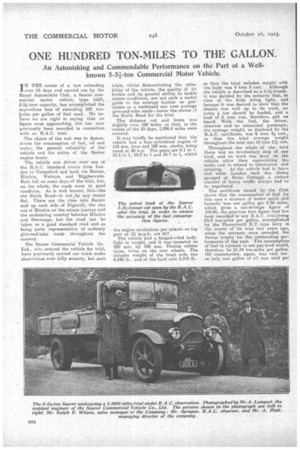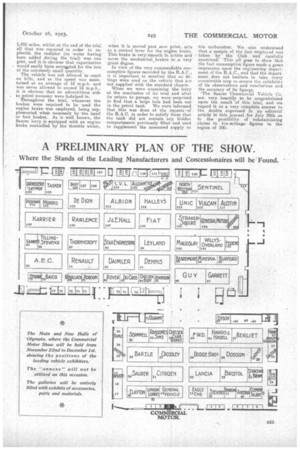ONE HUNDRED TON-MILES TO THE GALLON.
Page 8

Page 9

If you've noticed an error in this article please click here to report it so we can fix it.
An Astonishing and -Commendable Performance on the Part of a Wellknown 5-51-ton Commercial Motor Vehicle.
TN THE course of a test extending -I-over 10 days and carried out by the -Royal Automobile Club, a Saurer commercial motor vehicle, type SAD, 6.51-tons capacity, has accomplished the marvellous feat of' exceeding 100 ton niles gallon of fuel used, We believe we are right in saying that no hgure even approaching this has ever previously been recorded ie connection with an R.A.C. trial.
The object of the test was to demonstrate the consumption of fuel, oil and water, the general reliability of thevehicle and the action of the Saurer engine brake.
The vehicle was driven over one of the R.A.C. standard routes from London to Tempsford and back via Barnet, Hitchin, Welwyn and Biggleswade. Rain fell on some days of the trial, but, on the whole, the roads were in good condition. As is well known, this—the old Ndrth Road—is notiby any means flat. There are the rises into Barnet and up each side of Digswell, the rise out of Hitchin on the return journey and the undulating country' between Hitehin and Stevenage, but the road can be taken as a good standard road and as being quite representative of ordinary give-and-take roads throughout the country,
The Sauter Commercial Vehicle Co.. Ltd., Who entered the vehicle for trial, have previously carried out trials under observation over hilly eountry, but such trials, whilst demonstrating the ,reliability of the vehicle, the quality of its brakes and its general ability to tackle severe conditions, are not such a useful guide to the average haulier or purchaser as a continued run over average give-and-take roads—hence the choice of the North Road for the trial.
The distance out and home was slightly over 100 'miles, so that, in the course of the 10 days, 1,006.6 miles were covered.
It may briefly be mentioned that the vehicle had a four-cylindered engine of 110 mm. bore and 180 mm. stroke, being rated at 30 le.p. The gears are 6.1 to 1, 10.4 to 1, 19.9 to 1 and 38.7 to 1, whiist the engine revolutions per miisute on top gear at 12 m.p.h. are 617.
The vehicle riad a hinged-sided body. light in weight, and it was-mounted on 850 ram. by 160 mm. Dunlop rubber tyres, twins on the rear wheels. The unladen weight of the front axle was 4,340 lb., and of the back axle 5,316 lb.. so that the total unladen weight with the body was 4 tons 8 cwt. Although the vehicle is described as a 5-4-tonner, it was decided by the entrants that, in view of the body being light, and because it was desired to show that the chassis was well up to its work, aa extra ton should be loaded, and a load of 6 tons was, therefore, put on beard. With the _fuel, the driver, observer and an occasional passenger, the average weight, as disclosed by the R.A.C. certificate, was '6 tons 4 cwt., so that the total average weight throughout the trial was 10 tons 121 cwt.
Throughout the whole of the hi'd there was no involuntary stop of any kind, and no work was done on the vehicle other than replenishing the tanks and to attend to lubrication and greasing. As the vehicle had to leave and enter London each day (being garaged at Swiss Cottage) a certain amount of heavy traffic always had to be negotiated.
The certificate issued by the Club shows that the consumption of fuel (in this case a mixture Of motor spirit and henzole) was one gallon per 9.84 miles, which gives a ton-mileage figure of 104.66, the previous best figure that hes been recordediin any B.A.C. trialbeirig 69.3 ton-miles per gallon, accomplished by the Thornycroft B.T.-type lorry in the course of its trial two years ago, when the entrants were awarded the Dewar trophy for the outstanding performance of the year. The consumption of fuel in relation to net pay-load would, therefore, be 61.34 ton-miles per gallon. Oil consumption, again, was very low. as only one gallon of oil was used per 1,452 miles, whilst at the end of the trial all that was required in order to replenish the radiator (no water having been added during the trial) was one pint, and it is obvious that vaporization would easily have accowated for the loss of the extremely small quantity.
The vehicle was net allowed to coast on hills, and as the speed_ was maintained at an average of 12 m.p.h. and was never allowed to exceed 15 m.p.h„ it is obvious that no adventitious aids to petrol economy were indulged in. Throughout the trial, whenever the brakes were required to be used the engine brake was employed, being supplemented when necessary by the hand or foot brakes. As is well known, the Saurer lorry is equipped with an engine brake controlled by the throttle which, when it is moved past zero point, acts as a control lever for the engine brake. This brake is very smooth in action and saves the mechanical brakes to a very great degree. In view of the very commentIable consumption figures recorded by the R.A.C., it is important to mention that no fittings were used on the vehicle that are not supplied with the standard chassis. When we were examining the lofty at the conclusion of its trial and after its return to-garage, we were surprised to find that, a large hole had been cut in the petrol tank. We were informed that this was done at the request-of the It AC. in order to satisfy them that the tank did not contain any hidden compartments previously filled and used to supplement the measured supply to the carburetter. We also understand that a. sample of the fuel employed was taken by the Club and carefully examined. This all goes to show that the fuel consumption figure made a great impression upon the engineering departnient of the R.A.C., and that the department does net hesitate to take every conceivable step to ensure the reliability of its observations and conclusions and the accuracy of' its figures.
The Saurer Commercial Vehicle Co. are very heartily to be congratulated upon the resultof this trial, and we regard it as a very complete answer to the doubts expressed in an editorial article in this journal for July 24th as to the possibility of substantiating claims to ton-mileage figures in the region of 100.
































